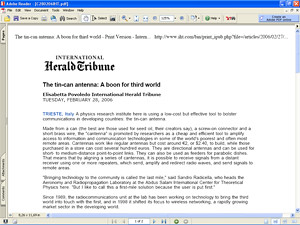
Elisabetta Povoledo International Herald Tribune
TUESDAY, FEBRUARY 28, 2006
TRIESTE, Italy A physics research institute here is using a low-cost but effective tool to bolster communications in developing countries: the tin-can antenna.
Made from a can (the best are those used for seed oil, their creators say), a screw-on connector and a short brass wire, the "cantenna" is promoted by researchers as a cheap and efficient tool to amplify access to information and communication technologies in some of the world's poorest and often most remote areas. Cantennas work like regular antennas but cost around €2, or $2.40, to build, while those purchased in a store can cost several hundred euros. They are directional antennas and can be used for short- to medium-distance point-to-point links. They can also be used as feeders for parabolic dishes. That means that by aligning a series of cantennas, it is possible to receive signals from a distant receiver using one or more repeaters, which send, amplify and redirect radio waves, and send signals to remote areas...
Download full article: http://www.megaupload.com/?d=V0TX5W3E
The tin-can antenna: A boon for third world
 27 July 2007 |
27 July 2007 |  Diketik oleh
Tukang Donlot
Diketik oleh
Tukang Donlot

 Tjap:
Hardware
Tjap:
Hardware
Subscribe to:
Post Comments (Atom)
Blog Archive
-
▼
2007
(85)
-
▼
July
(19)
- Linux Apache SSL PHP/FI frontpage mini−HOWTO
- Apache Overview HOWTO
- The Little Black Book of Computer Viruses
- Virus programming (not so basic) #2
- Virus programming (basics) #1
- Virus Collection (Isinya Macam-macam Virus, Lho)
- Building Internet Firewalls - O Reilly
- Firewalls and Internet Security: Repelling the Wil...
- Jangan Khawatir!
- CGI Programming Unleashed
- Rich Web Applications with Java and Ajax
- Understanding AJAX: Using JavaScript to Create Ric...
- Ajax For Dummies®
- WORKSHOP “nDESO” MEMBUAT ANTENA WAJANBOLIC
- Making a cantenna
- STEP BY STEP PEMBUATAN ANTENA KALENG (WAVE GUIDE)
- The tin-can antenna: A boon for third world
- How To Build A Tin Can Waveguide WiFi Antenna
- Yuhuuu...
-
▼
July
(19)
 RSS Feed
RSS Feed




0 cangkeman:
Post a Comment